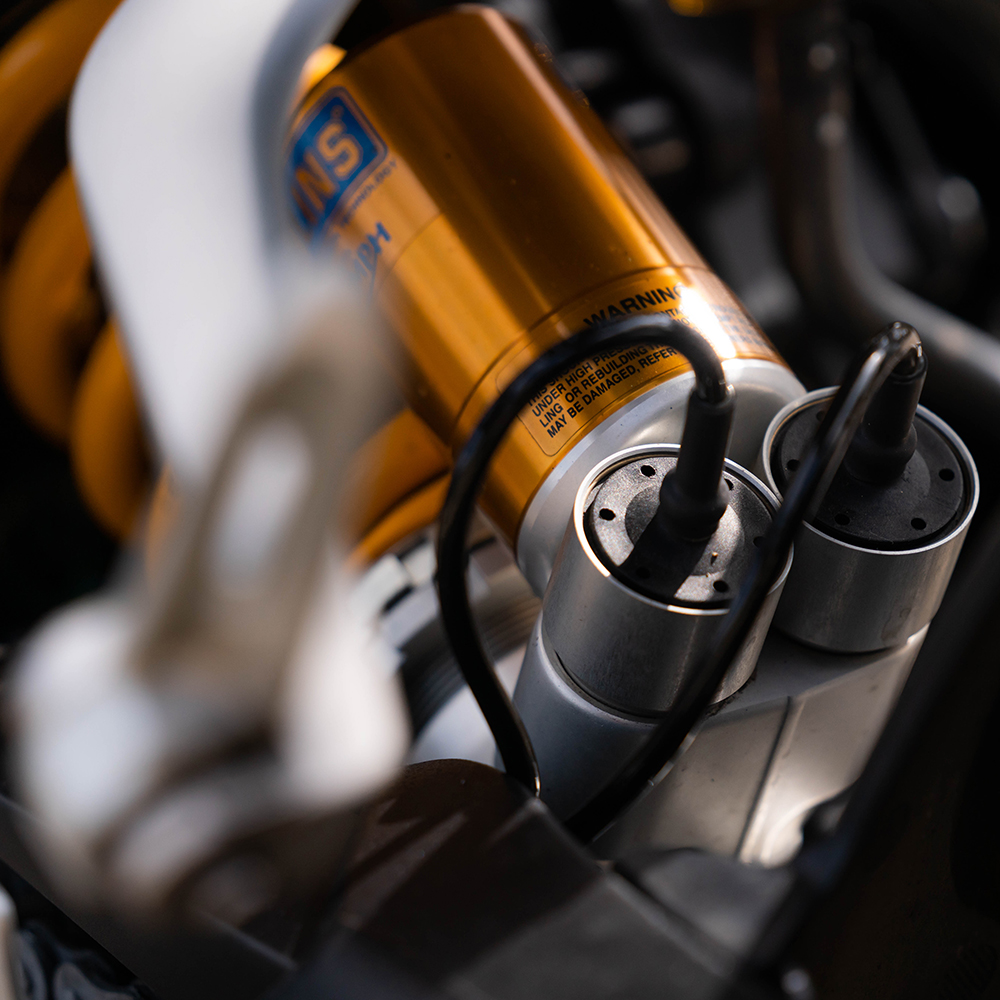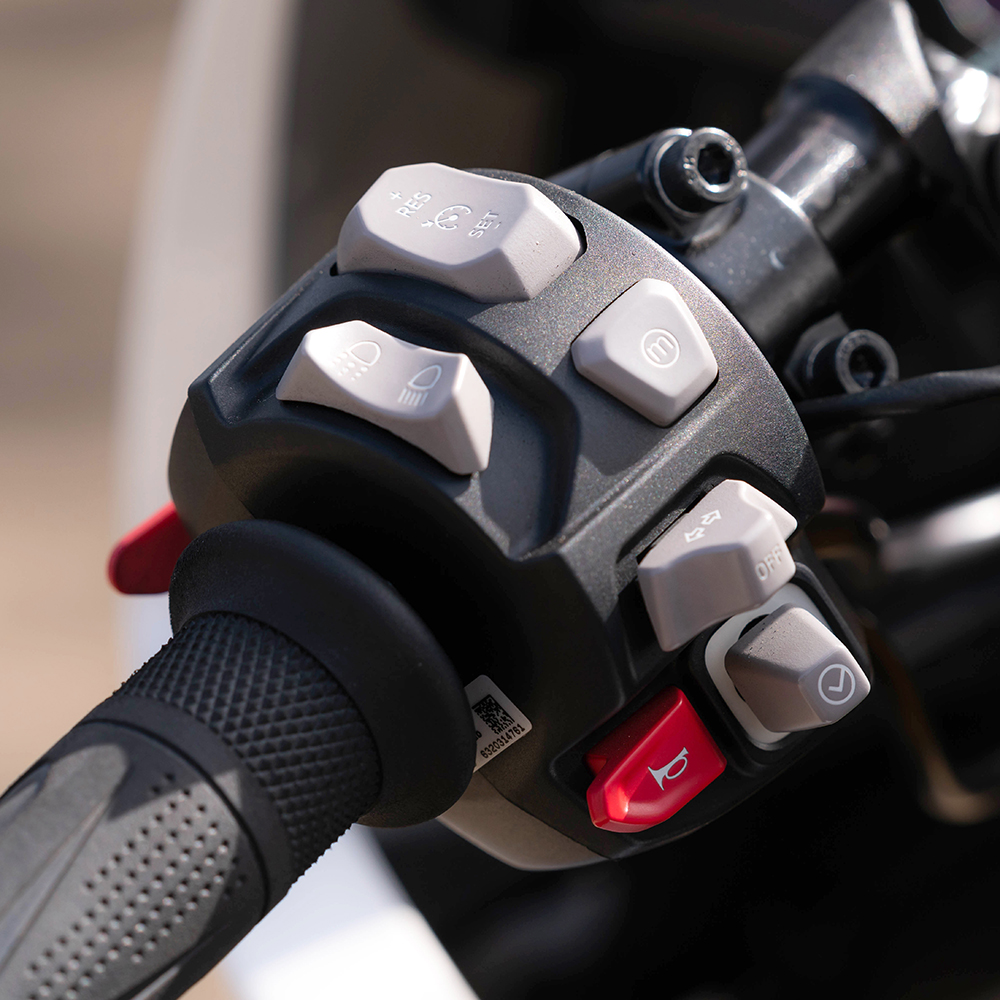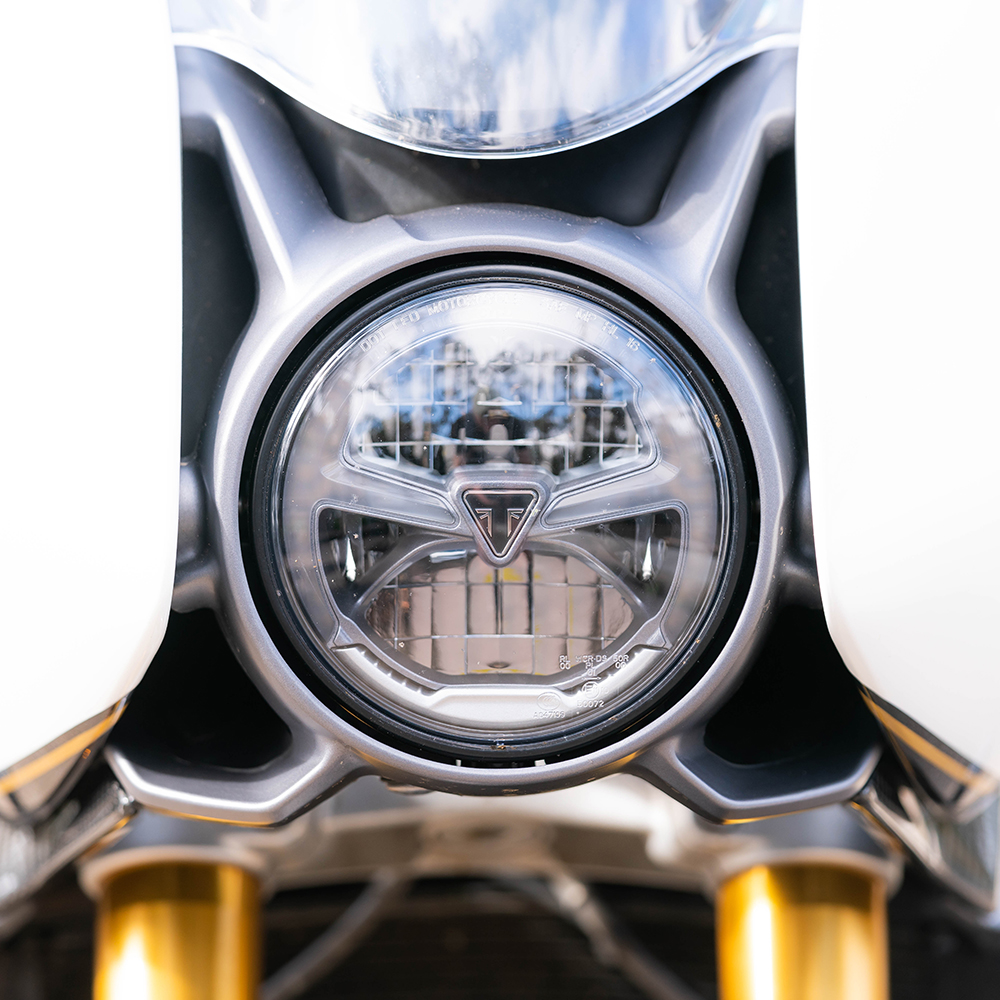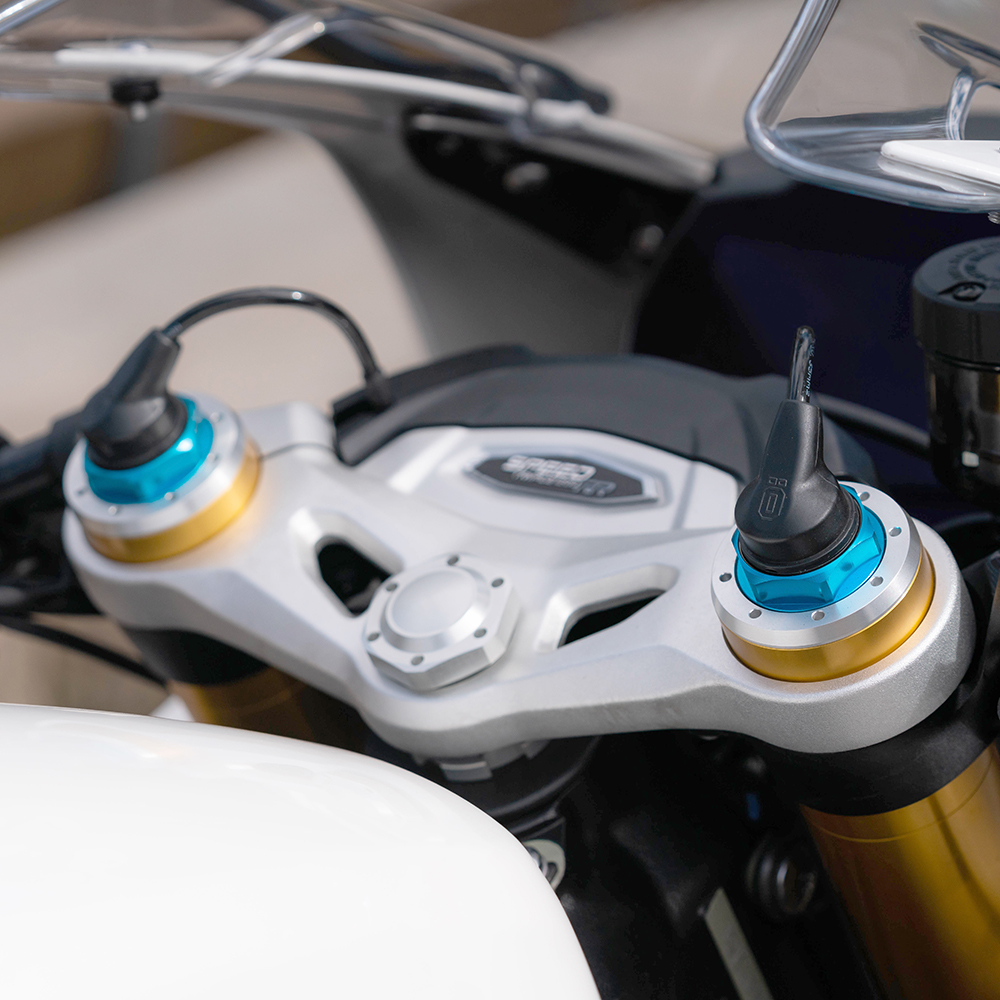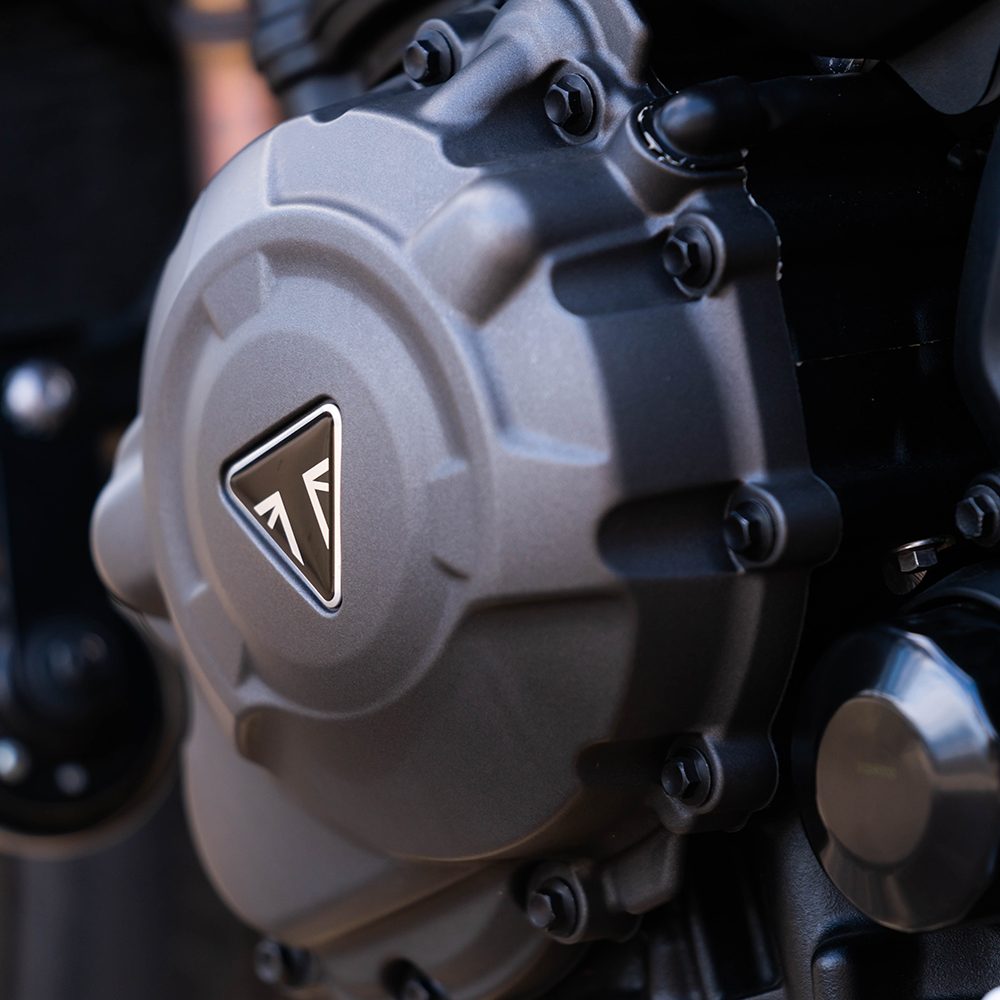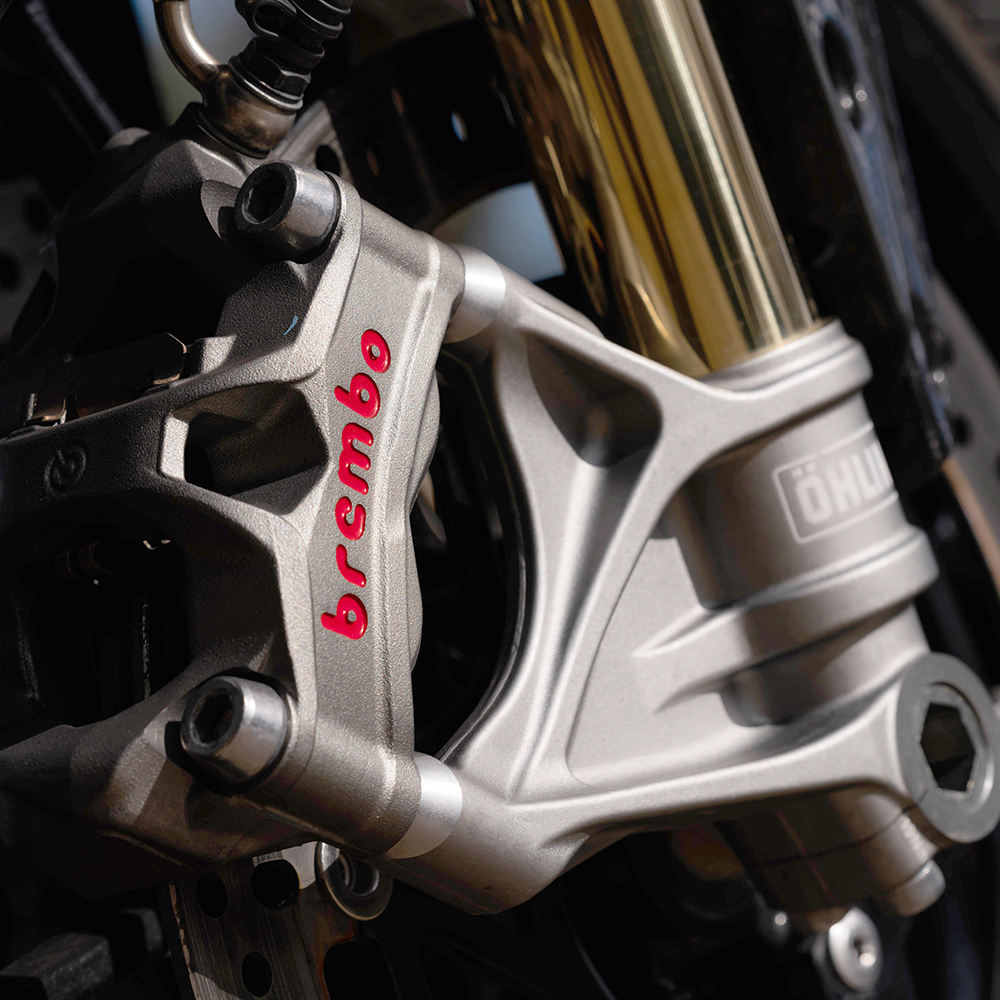Originally conceived by removing the fairings from a Triumph Daytona, the Speed Triple ups the ante with the new RR. A café racer-cum-superbike
I’m not sure if this is a case of reverse engineering or if Triumph has indeed gone full circle. The Speed Triple started its journey as a stripped-back Triumph Daytona back on 1995. The Speed Triple 1200 RR is now half a fairing away from being a Daytona 1200 once again.
The newly updated Speed Triple RS forms the base for the RR and parking them side by side will show how little difference there is between the two. Essentially, the ’bars have been swapped out for clip-on items, which moves them 135mm lower and 50mm further forward. It sounds like a lot – and it is. Along with moving the footpegs 15mm higher 26mm further back, it completely changes the character of the Speed Triple and plants it in Superbike territory.

There isn’t many bikes that I enjoy looking at almost as much as riding them, but the Speed Triple 1200 RR is a work of art. The kind of bike I want to park in the loungeroom and watch it glisten in the light of the television. The gold Öhlins suspension, Brembo braking system, carbon fibre accents and luscious paintwork looks so good that I could sit and admire it for hours. But bikes are meant to be ridden so enough of drooling, it’s time to hit the road.
When you jump on the Speed Triple 1200 RR you are immediately met with a racebike feeling. My wrists have some weight on them and I’m leaning right over the tallish fuel tank. Trying to get into a tuck position behind the tiny windscreen is almost impossible unless you wear size-small clothing.
- The engine’s like a gas turbine: power where you want it
- ‘A geek’s delight’: the back end of the electronic suspension
The view is dominated by the five-inch full colour TFT dash, the blue anodised fork caps and cables entering the fork indicate that you are blessed with the best suspenders on the road. Carbon fairing mounts tucked away down the side of the dash tell the story of a desire to minimise the weight increase over the RS. In fact, the extra fairing and electronic suspension only adds on kilogram to the RR compared to the RS.
The seat is quite firm and not too tall at 830mm, and I am able to plonk two feet on the ground which, at 175cm tall, isn’t the case on most ‘big’ bikes. I don’t find the riding position uncomfortable at all, but it is definitely an engaged sportsbike stance with relatively wide clip-on bars.
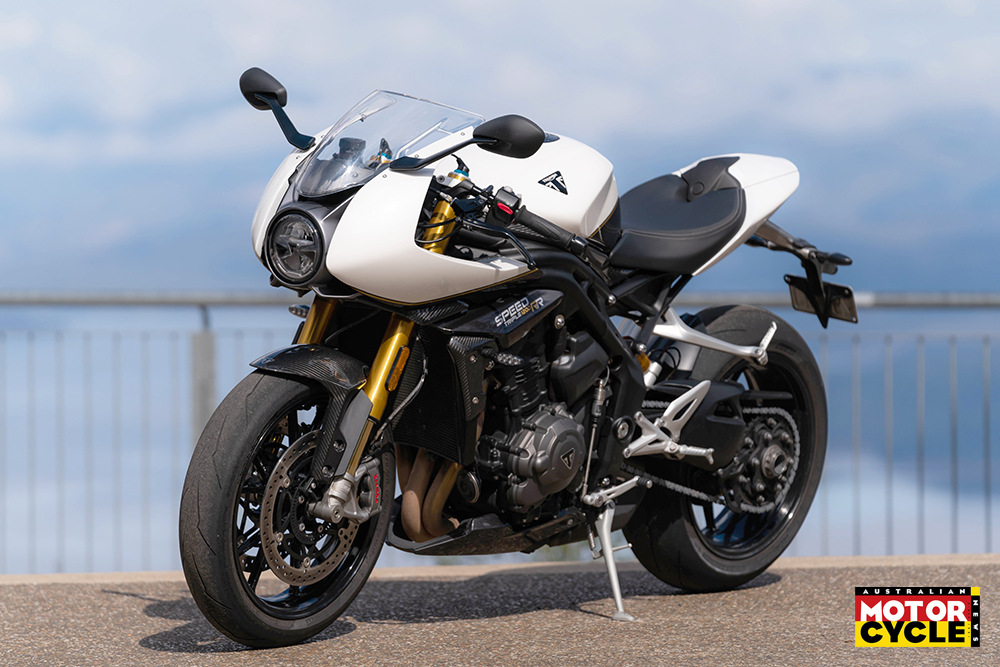
The 1160cc triple engine is the updated version found in the RS and it pumps out 132kW (177hp). Triumph have worked on the engine to reduce inertia for a more responsive and quicker-revving characteristic, while producing more power and mid-range torque. This was done by reducing crank inertia and minimising valve-train mass, as well as optimising all parts of the engine for less mass and more power. The gearbox is stacked to reduce the size and mass of the engine package also.
Firing it into life via the keyless system is easy and you are rewarded with the traditional 120-degree crank sound with a raspy exhaust note. The engine feels very responsive when blipping the throttle, but isn’t very noisy thanks to the two-stage exhaust system. The main muffler and emissions equipment is mounted under the engine out of view and to keep the weight low, with the secondary muffler – a pleasant-looking brushed stainless-steel jigger – mounted up the side in full view. Most of the engine’s sound comes from the Moto2-sounding induction wail under full throttle which is joyous to the ears but not so joyous to your demerit point score if you get caught up in the moment.
- Changing modes is only part of the electronic goodness
- Of course, a buttery-smooth quickshifter is part of the package
Power delivery is strong and linear from the bottom all the way to redline with a healthy push of torque through the mid-range. The power curve isn’t really a curve, it’s a 45-degree straight line from left to right. It’s like a gas turbine, more revs is more power all the way to the top. Keeping the front wheel on the ground would be impossible in the first three gears if not for electronic aids. It’s quite the handful.
My brain wasn’t quite ready for just how fast the Speed Triple 1200 RR is at first, I should have known better as the RR only weighs in at 199kg wet. It is a real eye opener for the uninitiated. The engine spins up rapidly thanks to those new engine internals, but in a minor trade off you need to have a few revs up your sleeve when taking off from a standing start. The slip and assist clutch grabs quite well and will catch you out if you don’t rev it enough. Once underway the two-way quickshifter allows clutchless shifting up and down the gearbox. The shifts are as slick as can be. It blips the throttle on downshifts to ensure you never miss a gear and the slipper clutch ensures the rear doesn’t lock up under compression braking. Finding neutral is a bit fidgety at times, but I think this is a symptom of having such a precise and light gearbox. It only takes a gentle click to get neutral.
All this speed needs a set of top-class brakes, so Brembo Stylema monobloc front calipers are fitted and grabbing a pair of lightweight 320mm discs. A bit of extra fruit is the Brembo MCS span- and ratio-adjustable front master cylinder, which allows you to select your preferred lever ‘feeling’ as well as the span adjustment. I prefer the precise 19mm setting which means a little more lever movement but better feeling as there is less effort required to squeeze the lever. At the rear there is a twin-piston Brembo caliper that works a treat.

The Speed Triple 1200 RR is loaded up with the best tech available, so a Continental MIB-EVO ABS modulator with its own IMU is fitted. This cornering ABS system is top spec and also controls the linked braking system. When at the track you can also select a Track mode that will allow you to back it in to corners (Moto2 style) and lift the rear wheel under hard braking (Toprak style). When the ABS is in track mode, the linked braking is also disabled. Initially when in Road mode I couldn’t really tell the linked braking was doing anything until I turned it off and realised it was helping the rear end to squat when the front brakes are applied, which helps to keep the wheels in line and reduce stopping distance. It is quite impressive tech when set up well.
- The Öhlins electronic suspension has seemingly endless options
- Triumph’s engineering prowess on full display with the 132kW powerhouse
The traction control system is equally impressive. It incorporates front-wheel lift control and is almost undetectable, it just feels like you’re a MotoGP rider carrying the perfect small wheelie out of a slow corner, or off from the lights. Switch the TC off, however, and you quickly realise the IMU was doing all the work for you as the headlight instantly starts looking for drop bears. The TC has four modes: Rain, Road, Sport and Track. Each allowing a little more wheelspin, slide and wheelie than the previous mode. The IMU constantly detects lean angle and will restrict throttle inputs while cranked over in a corner to keep you rubber-side down, as the bike begins to stand up there is more power on tap. If you are a gun, or simply want to do wheelies, it is easily turned off as long as you are stationary at the time. This changes if you’re in Track mode, though, then you can disengage TC on the fly.
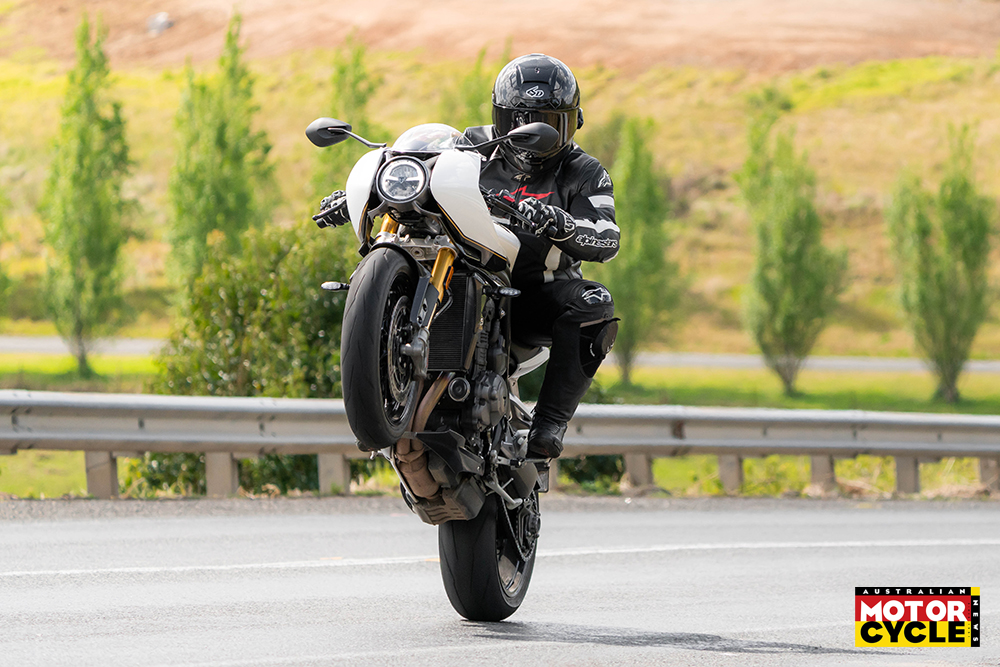
Next on the long list of top-shelf items found on the RR is Öhlins’ Smart EC 2.0 semi-active suspension system that tranforms the RR from a trackday weapon into a lazy Sunday scratcher for carving up your favourite set of twisties and it only takes about three clicks on the left-hand switchblock. Engage the system’s Comfort mode to soak up the most average of roads and the ride is quite plush, saving your energy for the good stuff. When arriving at a smoother section of road, switch it into Normal mode for a sportier feeling with more feedback through the ’bars and seat thanks to increased damping. Things are quite a bit stiffer in Normal mode, not unbearable, however you feel almost everything you ride over. There is also Dynamic mode which is aimed at track use and adjusts itself based on speed, lean angle, throttle and brake inputs to get the best performance.
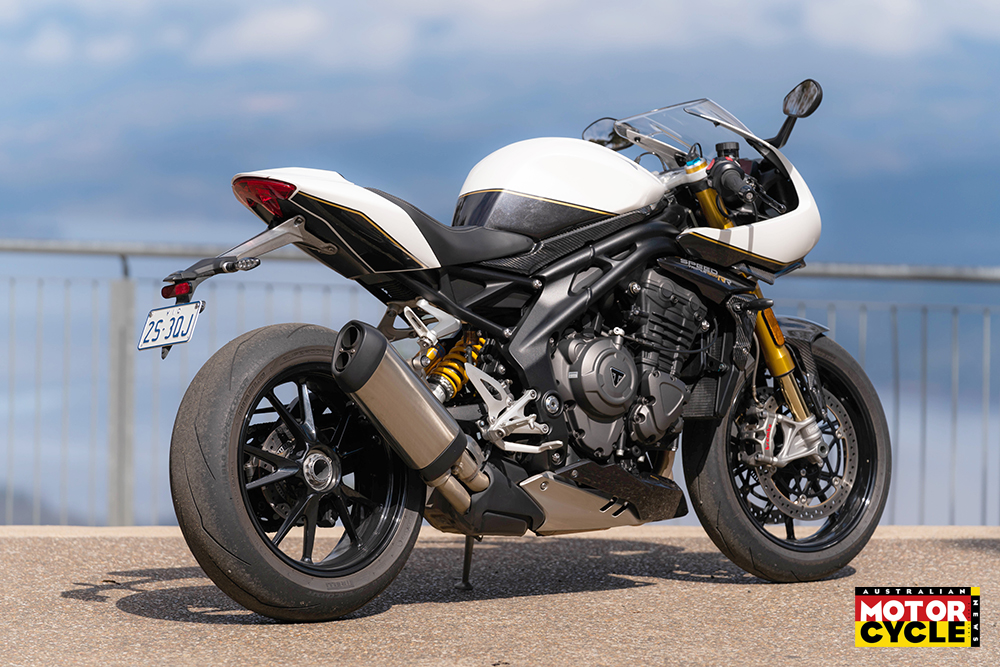
So how does all this translate to handing? Pretty good really. The RR does need a little coaxing into the corners and to change direction quickly, which I attribute to the RR essentially being a nakedbike whose wide ’bar required for leverage has been removed and replaced with clip-ons. The aggressive riding position loads up the front tyre nicely and the RR holds a line with the best of them. The suspension absorbs the bumps like I absorb doughnuts and doesn’t upset the bike’s trajectory in the corners like a bike with a much-stiffer chassis would.
The suspension shows its worth as you wind the power on hard out of corners. As the power delivery is so linear there is no unexpected peaks or flat spots to worry about, even with TC off, laying the power down and letting the bike squirm across the bumps is an adrenalin rush. The Pirelli Supercorsa SP V3 tyres are a perfect match for the RR. The dry grip feels almost endless and they suit the performance of the bike perfectly as they are arguably the stickiest road tyre money can buy – the lean angles you can get on the road are epic. The shoulder of the Pirelli tyre is the same compound rubber used in world supers.

The RR is definitely a special bike, I can almost imagine the Triumph engineers picking the best of every component and crafting it into this stunning superbike having a chuckle about how much fun it’s going to be to ride when they completed it. The built quality is as can be expected from Triumph – outstanding – and a great deal of attention has been put into every part of the bike. Like the full LED lighting with DRLs, the backlit switchblocks, the keyless ignition and fuel filler cap, carbon-fibre accents and the colour-coded rear seat cowl, to name a few.
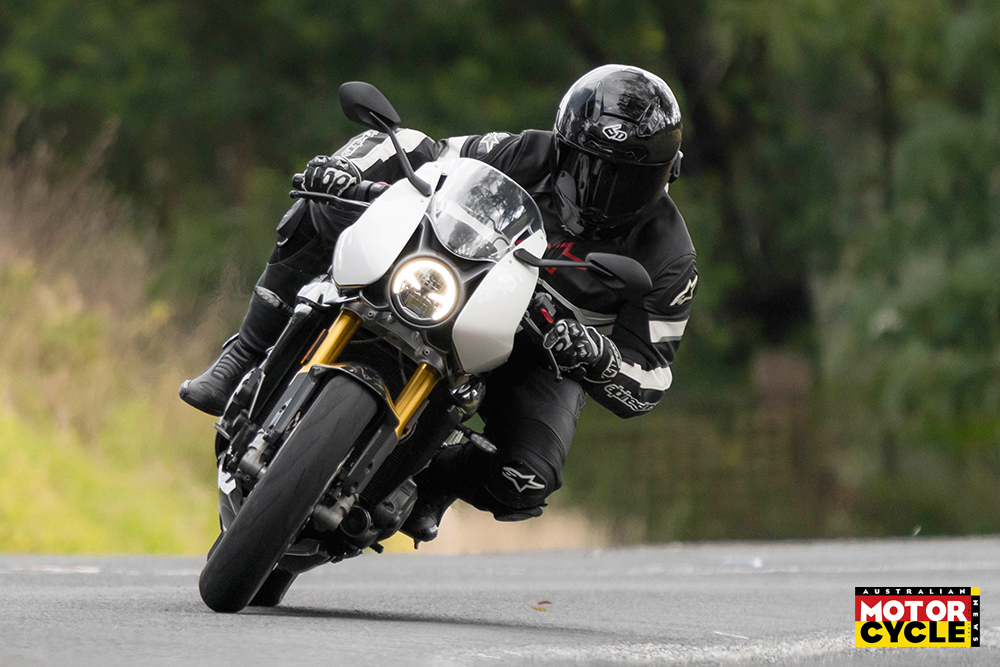
Of course, all this doesn’t come cheap, and this is reflected in the price. At $32,90 (ride away) for the white and grey one we are testing, the RR is $3900 more than the RS on which it is based on. There is a few extras over the RS, like the single headlight and fairing, carbon accents and the electronic suspension. I think the suspension alone almost justifies the difference in price, but the bike’s focus could be a bit too narrow for some. For example, pillion accommodation isn’t great, there is no storage for even a tyre-repair kit – under the pillion seat there is maybe enough space for a cigarette lighter but nothing more. The accessories catalogue does offer up a couple of small baggage options but they are limited to a rear seat bag and a small tankbag, so touring is probably off the table.

There is no doubting the Speed Triple 1200 RR is an absolute perler that puts the racer into café racer. It has multiple and useful personalities thanks the multitude of electronic aids which work to make your ride more enjoyable and, of course, safe.
Whether you’re riding track days, twisty back-roads or to your local cafe, I reckon you will struggle to find a better-specced or better-looking bike to do it on.
![]()
Pricey pairings
If you can afford an RR, you might want to look at these too
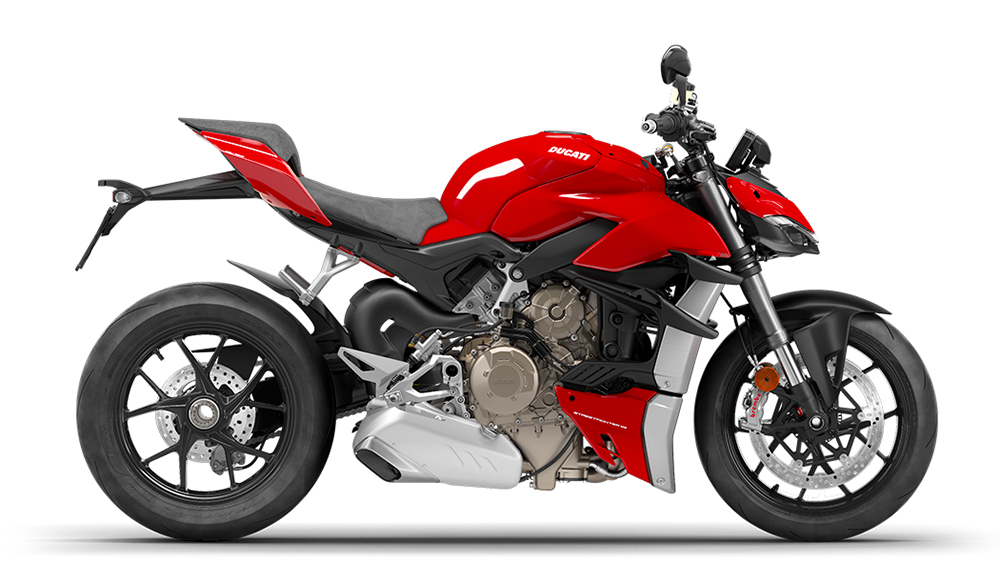
Ducati Streetfighter V4 S
$37,000 (ride away)
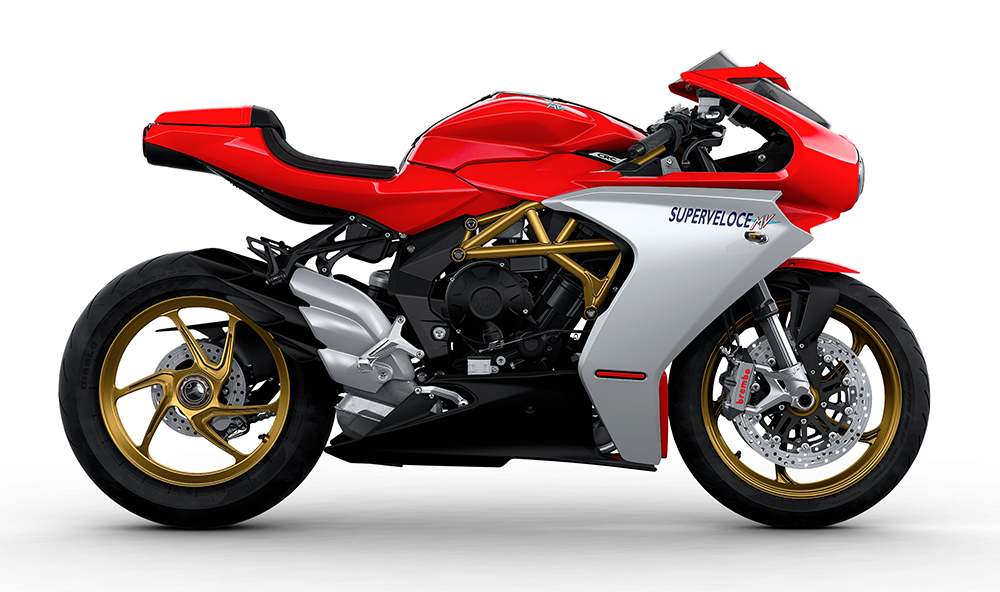
MV Agusta Superveloce 800
$42,990 (ride away)
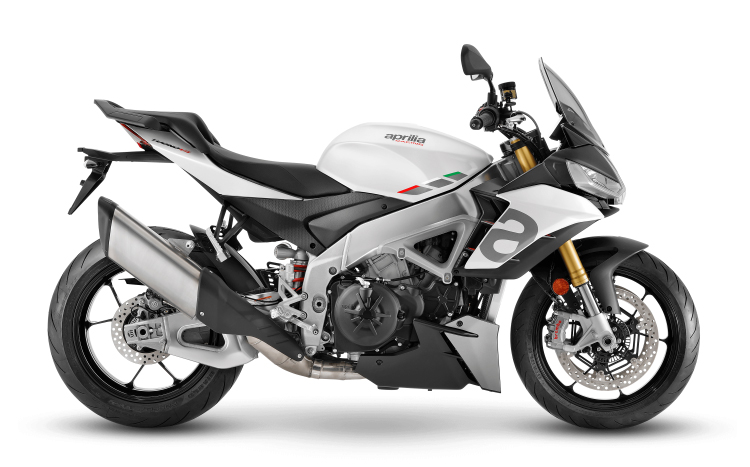
Aprilia Tuono V4
$28,830 (ride away)
![]()

SPECS
Engine
Capacity: 1160cc
Type: Inline triple, DOHC, four valves per cylinder
Bore & stroke: 90 x 60.8mm
Compression ratio: 13.2:1
Cooling: Liquid
Fueling: EFI
Transmission: Six-speed
Clutch: Wet, multi-plate, slipper
Final drive: Chain
Performance
Power: 132.4kW @ 10,750rpm (claimed)
Torque: 125Nm @ 9000rpm (claimed)
Top speed: 299km/h (est)
Fuel consumption: 6.3L/100km (measured)
Electronics
Type: Continental
Rider aids: ABS, traction control, front wheel lift control, cruise control, electronic damping and preload and quickshifter
Rider modes: Modes Road, Sport, Rain, Track and User
Chassis
Frame material: Aluminium
Frame type: Twin spar
Rake: 23.9º
Trail: 104.7mm
Wheelbase: 1439mm
Suspension
Type: Öhlins Smart EC 2.0
Front: 43mm USD fork, fully-adjustable, 120mm travel
Rear: Monoshock, fully-adjustable, 120mm travel
Wheels & brakes
Wheels: Cast aluminium
Front: 17 x 3.5 Rear: 17 x 6.0
Tyres: Pirelli Supercorsa SP
Front: 120/70ZR17 (58W)
Rear: 180/55ZR17 (75W)
Brakes: Brembo, ABS
Front: Twin 320mm disc, four-piston Stylema caliper
Rear: Single 220mm disc, twin-piston caliper
Dimensions
Weight: 199kg (wet, claimed)
Seat height: 830mm
Width: 758mm
Height: 1120mm
Length: 2085mm
Ground clearance: Not given
Fuel capacity: 15.5L
Servicing & warranty
Servicing: First: 1000km
Minor: 16,000km
Major: 32,000km
Warranty: Two years, unlimited km
Business end
Price: $32,490 (ride away)
Colour options: Crystal White/Storm Grey or Red Hopper/Storm Grey (+$400)
Contact: triumphmotorcycles.com.au

